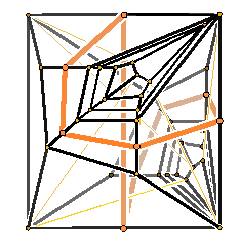

 |
A cubical 4-polytope with a dual Klein bottle.
A d-dimensional polytope is cubical if all its facets are combinatorially isomorphic to the (d-1)-dimensional standard cube; compare [1, Sect. 4.6].
It has been
observed by Stanley and by MacPherson that every
cubical d-polytope P determines a
normal crossing codimension one PL immersion
of an abstract cubical (d-2)-manifold into
(the barycentric subdivision of) the boundary
of the polytope: Each vertex of the dual
manifold corresponds to an edge of P
and each facet separates two opposite faces of
a facet of P.
In the case
a of cubical 4-polytope each
connected component of the dual manifold is a
cubical surface (compact 2-manifold without
boundary).
The immersed manifold is orientable if and
only if the 2-skeleton of the cubical d-polytope is ``edge orientable'' in the sense of Hetyei, that is, there is no
orientation of the edges such that in each 2-face opposite
edges are parallel.
Hetyei conjectured that there are cubical 4-polytopes that are
not edge-orientable [2, Conj. 2].
In [3] we obtain the first instance of a cubical 4-polytope (with 72 vertices and 62 facets) for which the immersed dual surface is not orientable: One of its components is a Klein bottle. This confirms Hetyei's conjecture.
This instance is constructed as follows (we refer to [3] for the details):
Model produced with: polymake 1.5.1 + additional tools
| Keywords | cubical complexes; cubical polytope; regular subdivision; dual surface immersion; Klein bottle | |
| MSC-2000 Classification | 52B12 (52B11, 52B05) | |
| Zentralblatt No. | 05264899 |
Submitted: Fri May 21 18:25:54 CEST 2004.
Revised: Fri Nov 19 15:19:33 CET 2004.
Accepted: Mon Nov 29 13:51:04 MET 2004.
TU BerlinGünter M. Ziegler
Inst. Mathematics, MA 6-2
10623 Berlin
Germany
schwartz@math.tu-berlin.de
http://www.math.tu-berlin.de/~schwartz
TU Berlin
Inst. Mathematics, MA 6-2
Strasse des 17. Juni 136
10623 Berlin
Germany
ziegler@math.tu-berlin.de
http://www.math.tu-berlin.de/~ziegler